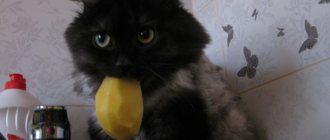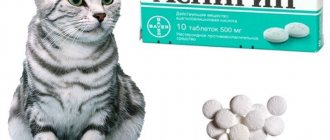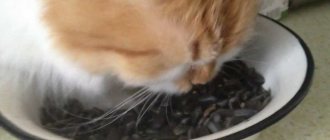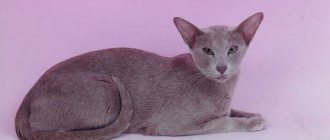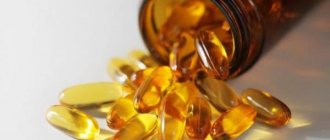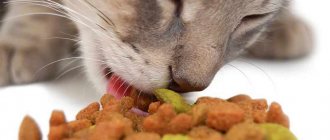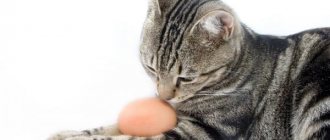About the beneficial properties of the liver
The benefits of liver as a product for humans are obvious. Is it possible to give this food to a cat? It would be useful to know the opinion of veterinarians. And they unanimously claim that liver for cats is necessary as an additive to the diet. But you cannot use this offal as a basis, replacing meat with it, despite the fact that the liver is very useful.
Beneficial properties of beef liver:
- it contains water-soluble B vitamins, which are responsible for healthy elastic skin and elastic, bright, shiny coat of the cat, its energy and good functioning of the gastrointestinal tract;
- The offal is rich in retinol (vitamin A). It increases bone density and strength, visual acuity of cats, and also strengthens the animal’s immune system;
- the liver contains tocopherol (vitamin E) and ascorbic acid (vitamin C) - necessary substances to increase the cat’s immunity and the body’s absorption of important microelements.
Meat by-product is high in vitamins:
- D – plays an important role in the body, necessary for better absorption of calcium;
- E – for good functioning of the circulatory system, proper production of hormones, improved cellular respiration and healthy reproductive function;
- K – necessary to improve blood clotting.
The liver contains valuable microelements - iron, phosphorus, magnesium, sodium, zinc and essential amino acids. An important beneficial property is the high nutritional value of the offal - useful animal protein is 25%, fats - only 5%, the composition contains a large number of essential amino acids and fatty acids. However, despite the obvious benefits of this product, feeding cats with liver can harm the animal.
How to feed cats and cats correctly?
The key to the longevity and health of a cat directly depends on a balanced diet. It is important for pet owners to understand that cats need animal foods: essential fatty acids and essential Omega-3 fatty acids come from animal protein and fat, which means they should form the basis of their diet. Vegetable protein obtained from cereals is incomplete for cats, as it does not contain all the vital amino acids (including essential ones, which enter the body only with food).
Types of vitamins and their effect on the pet’s body
| Vitamin A | helps strengthen the immune system and stimulate cell renewal, supervises vision |
| B vitamins | are responsible for the condition of the skin, coat and for maintaining proper energy levels, and also improve the functioning of the digestive tract |
| Vitamin C | participates in the absorption of important microelements, one of the most important antioxidants |
| Vitamin D | Helps improve calcium absorption |
| Vitamin E | is a powerful antioxidant, improves cellular respiration, affects the correct functioning of the circulatory system, organs that produce hormones and supports reproductive function |
| Vitamin K | necessary for the synthesis of proteins involved in blood clotting |
A lack of vitamins can always be tracked by the behavior, condition and appearance of your beloved cat.
When choosing what to feed your furry pet, take into account its characteristics: the presence of chronic diseases and physiological conditions (pregnancy, lactation, active growth, age-related changes). It is assumed that all the body’s needs can be met, while avoiding elemental deficiencies, by maximizing the variety of the cat’s menu. We are, of course, talking about permitted products and, first of all, about the variety of meat varieties and types of offal. So can cats have chicken liver?
What is harmful to the liver?
There are several reasons why it is not recommended to give your pet raw liver:
- any liver is a filtration organ containing toxins; in addition, it is often parasitized by helminths or their eggs and larvae. Therefore, raw liver in an animal’s diet is a threat of helminthiasis;
- liver as an offal is high in calories. Frequent feeding of it can lead to rapid weight gain and obesity;
- vitamins found in the offal tend to accumulate in the cat’s body, which can cause hypervitaminosis and, as a result, diarrhea, vomiting, hair loss and muscle pain.
Raw liver takes a very long time and is difficult to process in the cat’s body. This is a serious burden on her gastrointestinal tract and digestive organs. Cats can be especially affected: they are more likely than cats to experience constipation or diarrhea. Therefore, veterinarians and cat breeders are extremely careful when feeding animals raw liver.
Healthy Liver Alternatives
Adult cats can benefit from eating a little boiled liver from time to time, but it is not suitable for everyone. Fortunately, there is a simple alternative - commercial feed containing the same product, but in smaller quantities. Moreover, it can be either dry food, canned food or spiders. It is best if the composition indicates “fresh” or “freeze-dried” liver. By checking out different brands, you can find cat food or treats that are safe and enjoyable for your cat.
Photo source:
Basic feeding rules
How to properly introduce beneficial substances from the liver into a cat’s diet without harming the animal? Veterinarians advise adhering to the following recommendations when introducing offal into a cat’s diet:
- give boiled liver, keeping it in boiling water for 5-10 minutes, since during prolonged cooking some of the vitamins are lost;
- feed no more than 1-2 times a week;
- a serving of liver should not account for more than 10% of a cat’s daily diet;
- buy and give your pet only a high-quality product.
You should also keep in mind that not all types of liver are equally beneficial for your cat. There are no problems with purchasing dietary medicinal offal now. You can choose chicken, pork, or beef. But of all types of liver, beef is preferable. It contains more protein that synthesizes iron proteins, which improve the composition and quality of the pet’s blood. Beef liver is high in taurine, an essential amino acid that keeps your cat healthy and strong. The norm of beef, according to veterinarians, in a cat’s diet should be no more than 5%
Chicken liver is less useful; it contains less healthy proteins, but more fat. Pork liver is inferior in health to chicken and beef. Pork liver contains more toxins and fats, which increase the level of “bad” cholesterol in the animal’s blood. Therefore, many veterinarians do not recommend introducing pork liver into the diet of cats. In addition, it has a bitter taste, which is why animals themselves refuse such food.
How and in what quantities can you give
The opinions of experts mostly agree that it is more advisable to feed cats raw liver, because more than half of the nutrients are lost in the processed product. The optimal amount is 1 time per week. Otherwise, there is a high risk of harming the animal’s intestines: the cat may develop diarrhea. Boiled liver can be given more often, but remember that it has a fixing effect and can cause constipation.
Despite the fact that in its raw form the product can sometimes cause unwanted reactions, nutritionists allow it when following a natural diet for cats. It is allowed to feed raw liver to kittens: the nutrients, vitamins, and minerals contained in it are necessary for the active development of the growing organism.
Dosage in diet
To minimize the risk of unwanted reactions to liver, it should be introduced gradually into the daily menu of cats. They begin to feed the pet with small pieces, and then give them in small portions (no more than three times a week!). A cat should consume no more than 10 grams of liver per 1 kg of live weight per day.
It is unacceptable to give cats liver dishes containing fried onions, salt and spices.
For reference: the total volume of food from all feedings per day is calculated using the formula*: up to 9 months. 10% and older than 9 months. 5% of body weight (it is calculated without taking into account body fat, of course, approximately). The resulting daily volume of food is divided in half between 50% fermented milk products, 50% raw meat and everything related to meat (beef offal, poultry, fish). The amount of raw plant food should be approximately 5-10% of the volume of the meat portion.
*The formula is not absolute and mandatory. It is necessary to determine the cat’s feeding regimen, as well as the amount of food, taking into account the physiological state (pregnancy, breed tendency to be overweight, the presence of hormonal disorders, sterilization, etc.); age (old and aging animals should be given less food), as well as other individual characteristics. Do not forget about consultations with doctors.
How to choose the “right” liver
When choosing an offal for your pet, do not skimp; choose high-quality beef or chicken liver. By buying a low-quality, cheap product for an animal, you risk its health. Basic rules when buying liver in a store:
- Make sure that the purchased product is fresh. Therefore, it is not recommended to buy frozen liver - it is very difficult to check its quality and shelf life;
- pay attention to the color of the offal. A greenish tint to the liver indicates that bile has spread out of the gallbladder during slaughter and the product is spoiled. A bright orange or pale color of the liver indicates non-compliance with the temperature conditions for storage or transportation or repeated defrosting/freezing. The loose matte surface of the offal indicates improper storage or the expiration date of the product.
A high-quality liver is characterized by the following features:
- has a dense structure;
- the surface is smooth and shiny;
- The color of the product is rich brown-burgundy.
If a product has all of the above characteristics, feel free to introduce it into your pets’ diet.
How to prepare chicken necks
Necks, like heads, are often sold frozen and in packages.
As with the heads, they need to be thawed, rinsed with water and cleaned of skin and fat (the fat contained in any meat, but not visible to the naked eye, is quite enough). Then they need to be cut into pieces 1.5 - 2 cm long. The necks are quite easy to cut, you just need to try to guide the knife blade between the vertebrae. Instead of cutting into pieces, you can flatten the necks a little with a hammer. Then also distribute into portioned containers and freeze. For variety, it’s a good idea to form portions of heads and necks in a 50/50 ratio. Important!
A cat that is accustomed to human food or industrial feed is unlikely to be happy about changing its usual diet to heads and necks. You can learn how to correctly transfer a pet from one type of food to another in the article How to transfer a cat from commercial food to natural food (or vice versa).
Contraindications for feeding
Not all cats tolerate a particular food equally. When introducing liver into your pet's diet, pay attention to the animal's condition. If your cat begins to have problems with stool - constipation or diarrhea - limit or completely remove liver from the animal’s menu.
Liver is contraindicated in animals:
- having diseases of the digestive system and gastrointestinal tract;
- prone to allergies;
- obese or overweight;
- cats with pancreatic diseases.
Important!
Unprocessed liver has a laxative effect, while boiled liver, on the contrary, strengthens it. This must be taken into account when feeding animals with digestive problems.
A selection of ready-made cat foods containing liver
| Photo | Name of food | Price | Delivery: |
| Happy Cat cat food with beef, liver and peas, 100 gr. | From 50 ₽ | Across Russia | |
| Food for sterilized cats Pro Plan Opti Savour with duck, with liver. Weight from 0.4 to 10 kg. | From 297 ₽ | Across Russia |
Recipe examples
The approximate diet of cats on a natural diet should be as follows (grams per day):
| Product | Adult cat | Kitty | |
| 1-3 months | 3-6 months | ||
| Meat products | 80-120 | 10-60 | 60-80 |
| Fish and seafood | 80-100 | 8-50 | 50-60 |
| Fermented milk or milk (for kittens) | 100-200 | 30-100 | 100-130 |
| Cottage cheese and cheeses | 30-50 | 5-10 | 10-15 |
| Cereals | 50-80 | 20-50 | 50-70 |
| Animal fats | 5-8 | 1-2 | 3 |
| Vegetable fats | 3-5 | 0,5-1 | 1-2 |
| Fish fat | 1,3 | 0,5-1 | 1-1,5 |
| Chicken eggs | 1-2 pieces per week | ||
| Vegetables and fruits | 30-40 | 15-20 | 20-30 |
| Meat and bone meal and fish meal | 25-30 | 7-15 | 15-25 |
At first, it is very difficult for an inexperienced owner to create a competent, complete and varied diet of natural food for a pet. Here are some examples of nutritious and delicious foods that all cats love.
Veal meatballs
It is convenient to prepare them in large quantities and freeze them in the freezer. You can give it to your pet daily based on the daily norm based on the pet’s age and weight. The temperature of the product in the animal’s bowl should not be lower than room temperature.
For 1 kg of veal or beef you will need 100 g of rice, 200 g of vegetables (broccoli, corn, bell pepper).
Rice and vegetables are boiled. Then, together with the meat, they are passed through a meat grinder, 50 g of beef broth is poured in. You can add a tablespoon of olive oil. Then meatballs are formed from the finished mass, placed in a container or plastic bag and frozen.
This amount of food is usually enough to feed an adult cat for three days.
Cat ice cream
It can be used as a treat on a hot summer day.
200 g of low-fat cottage cheese must be combined with 100 ml of fermented baked milk. Mix thoroughly in a blender. Pour into special molds or plastic cups and place in the freezer.
Chicken pate
You can also use offal - heart, liver, stomachs of chickens. For 1 kg of meat component you will need one large carrot, 100 grams of walnuts.
Boil the carrots and chicken and pass through a meat grinder, add 200 ml of chicken broth and 50 grams of butter.
Can be divided into portions and frozen. This is a three-day diet for an adult pet.
Meat balls with rolled oats
For 1 kg of beef/veal/chicken in the form of minced meat, add 200 grams of boiled rolled oats, puree from one large carrot and one raw egg yolk. Form meat balls from the resulting mixture, freeze them in the freezer, and remove them as needed. Enough for an adult cat for three days.
Veal and broccoli cutlets
Take minced veal (1 kg), add 200 grams of raw broccoli or cauliflower puree, add a little olive oil, form small cutlets and freeze them.
Chicken liver pate
You will need chicken liver (200 g), hard cheese (50 g), half a banana, a tablespoon of 10% cow's cream and oatmeal (you can grind rolled oats).
All whole foods must be chopped and slightly simmered. Add cream and oatmeal, mix well. You can cool it and give it to your pet. Divide the leftovers into portions and place in the freezer.
The right diet
An animal will be much healthier and more beautiful if its diet is balanced, but how can this be achieved at home? Unsalted meat must be combined with boiled vegetables (cabbage or carrots) or porridge (oatmeal, rice, buckwheat, millet, etc.). You can feed your cat porridge every day, but you should definitely change the cereal. You can also introduce special vitamins or fish oil into your diet. All this hassle can be avoided by simply purchasing dry or wet balanced food. It has one big advantage - all trace elements, minerals and vitamins are present in the quantities required for the cat. And, of course, you should not give liver to kittens due to the difficulty of digesting the product. Food for the animal must be at room temperature, in no case hot or cold, the meat must be finely cut into pieces.
The rumen of ruminants is of greater nutritional value. It also contains the vitamins cats need, and the villi contain special microorganisms that activate the functioning of the stomach and intestines. You need to buy high-quality meat and only from trusted places, because most often tripe is given to pets raw.
Also, the cat should be gradually accustomed to broth or soup with skimmed fat in a flat saucer.
In any case, if you choose natural food for your pet, you should supplement its diet with various vitamin preparations, because your pet does not receive enough essential microelements from meat alone.
Every owner has the right to choose the food for his pet, but if you decide to feed your cat natural food, you should carefully monitor this and not exceed the permissible limits. You definitely need to know that you should never mix natural food and dry food, this can affect the health of your cat. If you have questions about feeding your cat, it is best to consult a specialist.

